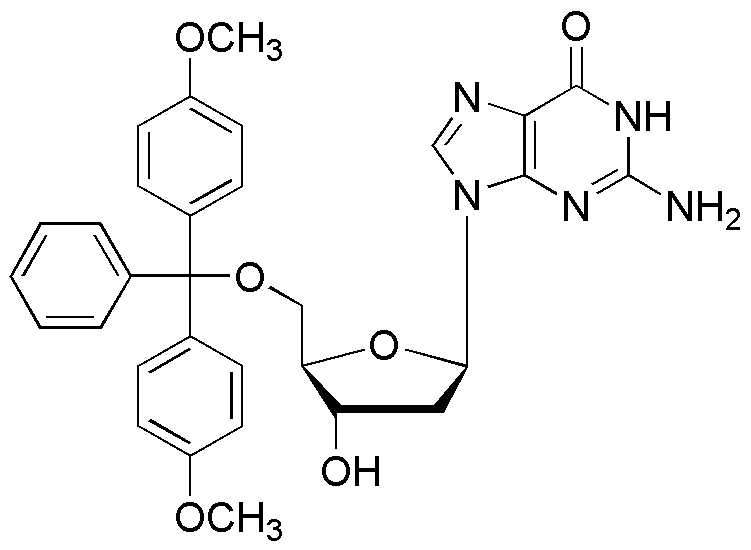5'-O-(4,4'-dimethoxytrityl)-2'-deoxyguanosine is widely utilized in research focused on:
- Nucleic Acid Synthesis: This compound serves as a crucial building block in the synthesis of oligonucleotides, which are essential for various genetic research applications, including gene editing and molecular diagnostics.
- Pharmaceutical Development: It plays a significant role in the development of antiviral and anticancer drugs by facilitating the design of nucleotide analogs that can inhibit viral replication or cancer cell growth.
- Biotechnology: In the field of biotechnology, it is used in the production of modified nucleic acids for therapeutic applications, enhancing the stability and efficacy of RNA-based therapies.
- Diagnostic Tools: The compound is employed in the creation of sensitive diagnostic assays, such as PCR and qPCR, which are vital for detecting genetic material in clinical samples.
- Research in Molecular Biology: It aids researchers in studying gene expression and regulation by providing a means to create modified nucleotides that can be incorporated into RNA transcripts for functional analysis.
General Information
Properties
Safety and Regulations
Applications
5'-O-(4,4'-dimethoxytrityl)-2'-deoxyguanosine is widely utilized in research focused on:
- Nucleic Acid Synthesis: This compound serves as a crucial building block in the synthesis of oligonucleotides, which are essential for various genetic research applications, including gene editing and molecular diagnostics.
- Pharmaceutical Development: It plays a significant role in the development of antiviral and anticancer drugs by facilitating the design of nucleotide analogs that can inhibit viral replication or cancer cell growth.
- Biotechnology: In the field of biotechnology, it is used in the production of modified nucleic acids for therapeutic applications, enhancing the stability and efficacy of RNA-based therapies.
- Diagnostic Tools: The compound is employed in the creation of sensitive diagnostic assays, such as PCR and qPCR, which are vital for detecting genetic material in clinical samples.
- Research in Molecular Biology: It aids researchers in studying gene expression and regulation by providing a means to create modified nucleotides that can be incorporated into RNA transcripts for functional analysis.
Documents
Safety Data Sheets (SDS)
The SDS provides comprehensive safety information on handling, storage, and disposal of the product.
Product Specification (PS)
The PS provides a comprehensive breakdown of the product’s properties, including chemical composition, physical state, purity, and storage requirements. It also details acceptable quality ranges and the product's intended applications.
Certificates of Analysis (COA)
Search for Certificates of Analysis (COA) by entering the products Lot Number. Lot and Batch Numbers can be found on a product’s label following the words ‘Lot’ or ‘Batch’.
Numéro de catalogue
Numéro de lot/série
Certificates Of Origin (COO)
This COO confirms the country where the product was manufactured, and also details the materials and components used in it and whether it is derived from natural, synthetic, or other specific sources. This certificate may be required for customs, trade, and regulatory compliance.
Numéro de catalogue
Numéro de lot/série
Safety Data Sheets (SDS)
The SDS provides comprehensive safety information on handling, storage, and disposal of the product.
DownloadProduct Specification (PS)
The PS provides a comprehensive breakdown of the product’s properties, including chemical composition, physical state, purity, and storage requirements. It also details acceptable quality ranges and the product's intended applications.
DownloadCertificates of Analysis (COA)
Search for Certificates of Analysis (COA) by entering the products Lot Number. Lot and Batch Numbers can be found on a product’s label following the words ‘Lot’ or ‘Batch’.
Numéro de catalogue
Numéro de lot/série
Certificates Of Origin (COO)
This COO confirms the country where the product was manufactured, and also details the materials and components used in it and whether it is derived from natural, synthetic, or other specific sources. This certificate may be required for customs, trade, and regulatory compliance.


